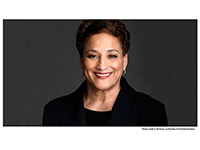New Realities of Aging
Aging is living: This is not how your grandparents did it
En español | As we celebrate Older Americans Month this May, we're reminded that aging today is much different than it was for our parents and grandparents. The convergence of longer life expectancy and technological advances is opening new doors to exploration and discovery as well as new expectations and possibilities for how we live and age. People today are challenging stereotypes and attitudes about getting older to create a new reality of aging in the 21st century.
Aging is about living. We are generally living longer and better than ever before. As we get older, we understand that our experience has value and look for ways to make the most of our added years. We also understand the rigors of family caregiving and recognize that we may need help in providing care for a loved one. And we wonder who will provide care if and when we need it.
We love the idea of being up on the latest smartphone or tablet, even though we may need help figuring it out. We are aware that as we get older, we will become more of a target for a scam or for identity theft, and we want to know how to protect ourselves. We are realistic. We know our needs are changing, and although we may not like it, we face it head on. We don't stop and withdraw from society because we become a certain age.
Not everyone is living longer. How people age differs widely based on gender, race and ethnicity. For example, in 2013 white males reaching age 65 could expect to live to 83. This is about 21/2 years less, on average, than white women, but 11/2 years longer than African American men. Affluence and education also influence longevity. Men in the upper half of income distribution now live roughly six years longer than they did in the 1970s, whereas men in the lower half live just 1.3 years longer. Shockingly, white women without a high school diploma actually lost five years of life expectancy between 1990 and 2008.
Where you live is also a factor in determining how long you will live. Life expectancy is nearly six years longer where I live, in Northern Virginia, than it is where I work, in Washington. In Cook County, Ill. (the Chicago area), there is a 33-year difference in life expectancy depending on where one lives.
Older people are contributors, not burdens. Frustratingly, a significant part of our government believes that addressing the needs of 106 million people over 50 — who generate economic activity valued at $7.1 trillion — is an unaffordable cost and a financial burden. Fortunately, more and more private-sector entrepreneurs are beginning to see the aging population as a great opportunity. People 50-plus in America comprise a new "longevity economy," which is larger than the economy of any country except China and the United States. Plus, as people enter extended middle age, they contribute to society socially as well as economically as volunteers, caregivers and grandparents. One of the true benefits of our increased longevity is having a growing number of older adults available to nurture and teach our young people today. What a wonderful blessing.
Aging spurs innovation. Our quality of life in the future will be determined by innovations in how products are designed, how services are delivered and how policies are implemented. Innovation is driving the new reality of aging, and technology is the driver of innovation. We have come to expect technology to help us live longer and better. We demand products and services that meet our every need. We're planning for the future: where we'll live, how we'll get around, how we'll stay connected, how we'll get health care and long-term care and how we'll make our money last. We're thinking about how to live a longer life in the best way possible, and we are drawn to innovations that help people of all ages live longer lives and improve the quality of life for everyone.
This Older Americans Month, let's keep these new realities in mind as we continue to blaze a trail for future generations of aging Americans.
Jo Ann Jenkins is CEO of AARP.
Disrupt Aging: A Bold New Path to Living Your Best Life at Every Age by Jo Ann Jenkins with Boe Workman (Public Affairs, April 2016), is available at Costco or DisruptAgingBook.org.
Video: Own Your Age and Embrace Growing Older - AARP CEO Jo Ann Jenkins believes that “aging is something to look forward to, not something to fear.” In this interview, she discusses her book “Disrupt Aging”.


